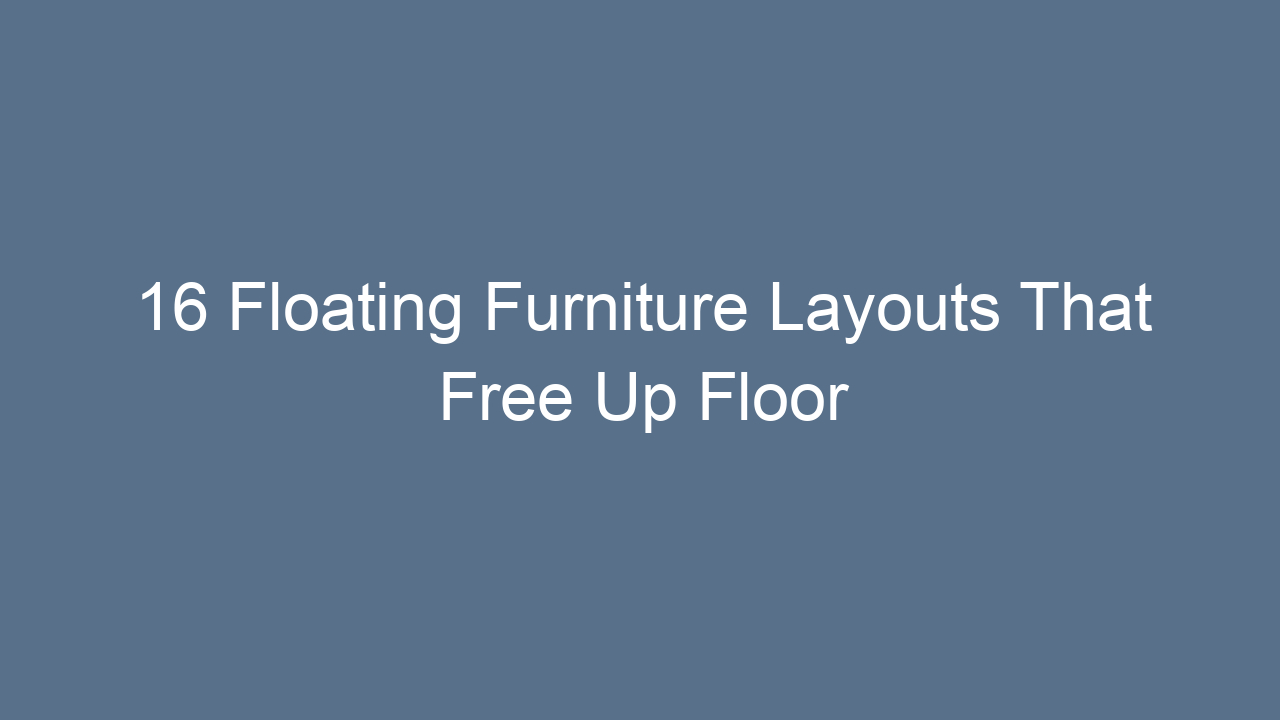16 Floating Furniture Layouts That Free Up Floor Space

Have you ever walked into a small room and felt like the walls were closing in? Many of us live in compact spaces where every inch counts. The secret to making these spaces feel larger lies in floating furniture layouts that free up floor space. Instead of lining everything against the walls, floating pieces allow breathing room, create flow, and even make small areas feel like designer showrooms. Think of it like giving your furniture a little “air” to breathe—suddenly, the room feels open, stylish, and functional.
Floating layouts aren’t just about looks; they solve real problems. They make walking paths clear, highlight focal points, and prevent the cluttered, boxed-in feeling. Whether you live in a tiny apartment or want to refresh your large living room, floating arrangements can change the energy of your space. Let’s explore 16 clever ideas to inspire you.
In This Article
- 1 1. Floating Sofa in the Middle of the Room
- 2 2. A Centered Rug as the Anchor
- 3 3. Double Sofas Facing Each Other
- 4 4. Floating Sectional for Compact Rooms
- 5 5. Chairs in the Center Instead of Walls
- 6 6. A Coffee Table as the Star
- 7 7. Floating Desk Setup for Work-Life Balance
- 8 8. Conversation Circles with Armchairs
- 9 9. Floating TV Stand with Seating Away from Walls
- 10 10. A Dining Table That Floats
- 11 11. Floating Daybed for Flexible Living
- 12 12. Benches That Float Near Rugs
- 13 13. Floating Ottomans as Flexible Pieces
- 14 14. Floating Bookshelves as Room Dividers
- 15 15. Floating Bed in the Bedroom
- 16 16. Mixing Floating Furniture for Layers
- 17 Final Thoughts
1. Floating Sofa in the Middle of the Room

Most people push their sofa against the wall, but imagine pulling it forward. A floating sofa instantly divides a room without building a wall. It works especially well in open-plan apartments where you want to separate the living area from dining or workspace. The space behind the sofa can also become useful—add a slim console table for storage or styling. This not only frees up the walls for shelves or art but also makes the seating feel more intentional. It’s like turning the couch into the star of the room rather than hiding it.
2. A Centered Rug as the Anchor
When arranging floating layouts, rugs play a huge role. A centered rug grounds the seating area while freeing the walls. Picture a large rug in the middle of the room with sofas and chairs floating on top. This trick creates a cozy “conversation island” in an otherwise plain room. It also visually stretches the space, making the room feel larger. Rugs act like invisible walls—soft dividers that organize without clutter. Instead of furniture hugging walls, everything gathers around this centerpiece, giving the floor edges a spacious look.
3. Double Sofas Facing Each Other
If you love hosting, try two sofas facing each other in the middle of the room. This layout feels balanced, inviting, and perfect for conversation. Instead of guests sitting side by side staring at a wall, they face each other naturally. This arrangement also frees wall space for other essentials like a media unit or bookshelves. Add a coffee table between the sofas, and suddenly the entire layout feels like a modern lounge. It’s both elegant and functional—like having a cozy café in your living room.
4. Floating Sectional for Compact Rooms
Sectionals are often bulky, but when floated, they can make small rooms feel stylish. A floating sectional sofa creates a clear boundary for seating without cramping walls. Place it slightly away from the edges, leaving pathways behind. This not only makes walking easier but also avoids the heavy, boxed-in vibe sectionals can create. To maximize space, pair it with a wall-mounted TV or floating shelves. The contrast between heavy and light elements brings balance, giving your room a polished yet airy feel.
5. Chairs in the Center Instead of Walls
Chairs are flexible, and floating them in the center of the room can free up corners for storage or décor. Imagine two accent chairs placed diagonally with a small side table—suddenly you’ve created an intimate nook. This trick works wonders in small living rooms where sofas dominate. Floating chairs are also easy to move, giving you the freedom to change layouts for different occasions. Instead of sticking them in forgotten corners, let them breathe in the middle. It feels fresh, stylish, and functional.
6. A Coffee Table as the Star
Sometimes, all it takes is letting the coffee table shine. By floating furniture around it rather than against walls, you create a central hub. Sofas, chairs, and ottomans can circle the table, leaving walls open for art or shelving. The coffee table becomes a gathering point—whether for tea, board games, or late-night conversations. This setup works beautifully in both small and large rooms, giving the space rhythm and flow. Plus, it’s an easy way to design around one strong statement piece.
7. Floating Desk Setup for Work-Life Balance
In today’s world, many of us work from home. Instead of shoving a desk into a corner, try a floating desk layout in the middle of a room. Place it near a window so natural light flows in. Behind the desk, you could add a storage unit or bookshelves. This setup not only keeps walls free but also creates a dedicated “office zone” without needing a separate room. It helps balance work and life, as the floating position keeps the desk from dominating every corner.
8. Conversation Circles with Armchairs
Want to encourage more personal chats? Create a conversation circle with floating armchairs. Four chairs arranged in a square or circle around a low table feels intimate yet modern. This layout works well in family rooms or open-plan spaces. Instead of everyone facing a screen, people turn toward each other naturally. It’s a layout that invites stories, laughter, and bonding. Best of all, the walls remain free for storage, art, or plants—keeping the room both functional and beautiful.
9. Floating TV Stand with Seating Away from Walls
Most TVs are against a wall, but a floating TV stand changes everything. Mount the screen on a slim divider or console in the middle of the room. Then, float the seating to face it. This setup works best in lofts or open spaces where one area needs definition. The beauty of this idea is that it frees the walls completely. Imagine lining those walls with bookshelves, cabinets, or even a mini bar. The entertainment zone feels stylish while keeping the floor open and free.
10. A Dining Table That Floats
Dining areas often look cramped because tables are pushed against walls. Instead, try a floating dining table in the middle. Chairs all around keep the space lively, while walls remain available for storage or décor. A pendant light above the table completes the look, making the area feel defined. This works well in small apartments where the dining space doubles as a multipurpose zone. Floating the table keeps movement fluid and makes meals feel more intentional.
11. Floating Daybed for Flexible Living
Daybeds are versatile pieces that can be sofa, guest bed, or lounge spot. A floating daybed in the middle of a room works like magic. It divides spaces without blocking light or sightlines. In studio apartments, a daybed can create a cozy sleeping area without heavy partitions. By floating it, you allow easy flow around both sides, making the room feel open. It’s one of the simplest ways to free walls while adding charm and functionality.
12. Benches That Float Near Rugs
Benches often go against walls, but moving them toward the center of the rug changes the mood. Picture a slim upholstered bench floating at the edge of a rug, defining a seating zone. It doesn’t block space but adds extra seating and style. Benches are also lightweight, so the floating arrangement feels airy. This idea works best in entryways, living rooms, or even bedrooms where you want seating that doesn’t steal focus.
13. Floating Ottomans as Flexible Pieces
Ottomans are the chameleons of furniture—they can be seats, tables, or footrests. Floating ottomans around a central rug or coffee table keeps the layout flexible. You can move them around as needed, but when grouped, they form a stylish focal point. Floating ottomans also leave wall space open for larger items like dressers or cabinets. This approach is perfect for people who love to host since seating can expand or shrink as needed without blocking the room’s flow.
14. Floating Bookshelves as Room Dividers
Not all floating layouts are about seating. A floating bookshelf divider can organize space while freeing up walls. Place a tall, open bookshelf in the center to separate living and dining areas. The beauty is that it doesn’t feel heavy—it lets light through while still defining zones. Unlike solid partitions, floating shelves serve double duty: they store books, plants, and décor while keeping the space airy. It’s an elegant way to add storage without clutter.
15. Floating Bed in the Bedroom
Bedrooms can benefit from floating layouts too. A floating bed—placed slightly away from the wall—adds depth and a boutique-hotel vibe. You can place a narrow console or bench behind the headboard, adding storage without overwhelming the room. This approach works especially well in small bedrooms where every inch matters. The free wall space can be used for wardrobes, artwork, or mirrors, while the floating arrangement makes the room feel sophisticated and open.
16. Mixing Floating Furniture for Layers
Finally, don’t feel limited to just one idea. The best spaces often mix floating furniture layouts for layers and flow. For example, float a sofa in the center, add chairs in a conversation circle, and finish with a floating bookshelf divider. The result is a dynamic room that feels spacious, stylish, and practical. By combining floating elements, you keep the floor open while creating multiple zones. It’s a layout that adapts to modern living—flexible, functional, and full of personality.
Final Thoughts
Using floating furniture layouts that free up floor space is like giving your home a fresh breath of air. It’s not just about saving space—it’s about creating flow, balance, and comfort. By letting furniture breathe and pulling pieces away from the walls, your room instantly feels bigger, lighter, and more inviting. Whether it’s a sofa, desk, bed, or bookshelf, floating arrangements make even the smallest spaces feel stylish and functional. Try one of these 16 ideas, and you’ll see your room transform into a space that not only looks beautiful but also feels right for your lifestyle.






